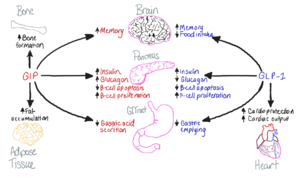User:Camille Gaudet/Sandbox 1
From Proteopedia
(Difference between revisions)
| Line 6: | Line 6: | ||
=== History === | === History === | ||
Interest in pancreatic hormones began at the turn of the 20th century. In 1902, [https://en.wikipedia.org/wiki/William_Bayliss Bayliss] and [https://en.wikipedia.org/wiki/Ernest_Starling Starling] discover a pancreatic [https://en.wikipedia.org/wiki/Secretin secretin] involved in regulation of water homeostasis, giving rise to interest in pancreatic hormones. Shortly after, in 1906, Moore et al. hypothesize involvement of [https://en.wikipedia.org/wiki/Gastrointestinal_hormone gastrointestinal hormone extracts] in maintenance of the endocrine pancreas. Jean La Barre purifies glucose-lowering gut extracts in 1929 and characterizes them as [https://en.wikipedia.org/wiki/Incretin incretins], which is short for intestine secretion insulin. Finally, in 1984, [https://en.wikipedia.org/wiki/Glucose-dependent_insulinotropic_polypeptide gastric inhibitory peptide] (GIP) is isolated from porcupine intestine. Although GIP was initially characterized for its gastric inhibitory effects (hence the name), it was also shown that the polypeptide played an integral role in [https://en.wikipedia.org/wiki/Insulin_signal_transduction_pathway insulin signaling and secretion]. Interestingly, it was found that the effect of GIP on insulin levels was still seen in its absence, hinting toward the presence of an additional incretin, which has now been classified as [https://en.wikipedia.org/wiki/Glucagon-like_peptide-1 glucagon-like peptide-1] (GLP-1). | Interest in pancreatic hormones began at the turn of the 20th century. In 1902, [https://en.wikipedia.org/wiki/William_Bayliss Bayliss] and [https://en.wikipedia.org/wiki/Ernest_Starling Starling] discover a pancreatic [https://en.wikipedia.org/wiki/Secretin secretin] involved in regulation of water homeostasis, giving rise to interest in pancreatic hormones. Shortly after, in 1906, Moore et al. hypothesize involvement of [https://en.wikipedia.org/wiki/Gastrointestinal_hormone gastrointestinal hormone extracts] in maintenance of the endocrine pancreas. Jean La Barre purifies glucose-lowering gut extracts in 1929 and characterizes them as [https://en.wikipedia.org/wiki/Incretin incretins], which is short for intestine secretion insulin. Finally, in 1984, [https://en.wikipedia.org/wiki/Glucose-dependent_insulinotropic_polypeptide gastric inhibitory peptide] (GIP) is isolated from porcupine intestine. Although GIP was initially characterized for its gastric inhibitory effects (hence the name), it was also shown that the polypeptide played an integral role in [https://en.wikipedia.org/wiki/Insulin_signal_transduction_pathway insulin signaling and secretion]. Interestingly, it was found that the effect of GIP on insulin levels was still seen in its absence, hinting toward the presence of an additional incretin, which has now been classified as [https://en.wikipedia.org/wiki/Glucagon-like_peptide-1 glucagon-like peptide-1] (GLP-1). | ||
| + | |||
| + | === Biological Role === | ||
| + | [[Image:GIP-GLP1-Purpose.png|300 px|right|thumb|Figure 1. The biological roles of GIP and and GLP-1, incretin hormones.]] | ||
| + | |||
== General Structure == | == General Structure == | ||
| Line 28: | Line 32: | ||
== Associated Diseases == | == Associated Diseases == | ||
| - | |||
| - | [[Image:GIP-GLP1-Purpose.png|300 px|right|thumb|Figure 1. The biological roles of GIP and and GLP-1, incretin hormones.]] | ||
== Medical Relevance == | == Medical Relevance == | ||
Revision as of 17:09, 24 April 2024
Glucose-dependent Insulinotropic Polypeptide Receptor
| |||||||||||
References
- ↑ Sun B, Willard FS, Feng D, Alsina-Fernandez J, Chen Q, Vieth M, Ho JD, Showalter AD, Stutsman C, Ding L, Suter TM, Dunbar JD, Carpenter JW, Mohammed FA, Aihara E, Brown RA, Bueno AB, Emmerson PJ, Moyers JS, Kobilka TS, Coghlan MP, Kobilka BK, Sloop KW. Structural determinants of dual incretin receptor agonism by tirzepatide. Proc Natl Acad Sci U S A. 2022 Mar 29;119(13):e2116506119. PMID:35333651 doi:10.1073/pnas.2116506119
Student Contributors
- Camille Gaudet


